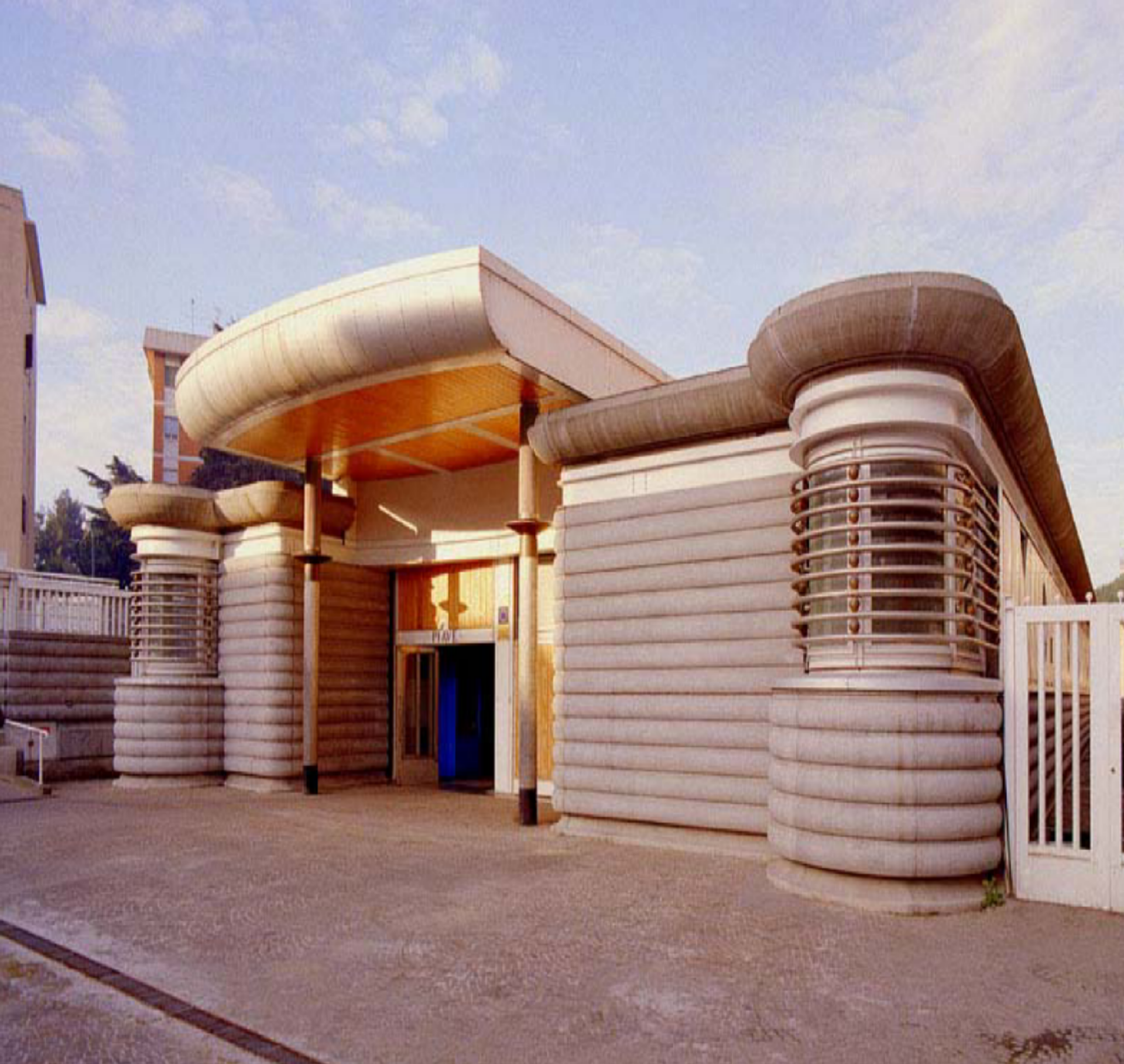
Le funzioni si sviluppano in modo lineare: prima dell’ingresso il locale per la vendita dei giornali; poi la hall con biglietterie automatiche e rivendita in contanti, uffici e locali a disposizione. Dopo le tornelle d’ingresso, i servizi igienici e le scale normali e mobili: sullo sfondo un grande mosaico sulla parete che divide la stazione dai suoi locali tecnologici .
L’edificio si presenta coma una lunga struttura in ferro con una parte basamentale in c.a. prefabbricato, configurato ad elementi ondulati. Tutto il ferro è verniciato in bianco, sia all’esterno che all’interno.
Le strutture verticali interne sono a loro volta rivestite in lamiera rivettata di acciaio inox satinato e di ottone. Le coperture interne sono in gesso, mentre le pareti sono rivestite in pietra bianca di Apricena e granito nero Africa. Nel complesso la struttura denuncia un dinamismo voluto, rappresentativo della “velocità” della funzione, ben inserito nel contesto privo di una forte connotazione, dando una immagine con un suo carattere forte e determinato.
The elements of the structure follow a linear path: before the entrance there’s the newsstand; then the hall with automatic machines selling tickets and the ticket office, other offices and annexed spaces; then the entrance turnstiles, the toilets, the escalators and the stairs. On the wall that separates the station from the trains there is a big mosaic. The building consists of a long iron structure with a prefabricated reinforced concrete corrugated base.
The iron is glazed white both inside and outside. The inner vertical structures are covered with glossed riveted inox steel and brass sheets. The inner covers are made up of plaster while the walls are covered with Apricena white stones and black Africa granite. As an overall view, the structure seems deliberately dynamic and the effect stresses “the speed” function of the place; that is how it gives emphasis and strength to the quiet and monotonous surrounding area.
Autore/Author: Nicola Pagliara
Nato a Roma nel ’33, conclude gli studi di Architettura nel ’59, e si dedica alla carriera universitaria ottenendo la cattedra di progettazione nel ’72. Dei primi anni di professione è la centrale telefonica di Benevento. Un particolare interesse per l’architettura mitteleuropea, per il futurismo italiano ed il costruttivismo russo, lo hanno portato a compiere molti viaggi di studio all’estero ed a scelte linguistiche vicine al mondo delle prime avanguardie.
Dopo aver progettato negli anni ’70 essenzialmente edifici in pietra, in occasione del progetto dell’impianto di sollevamento AMAN a Capodimonte (NA), analizza e verifica le possibilità concrete di un recupero espressionista del ferro e della pietra. In questo filone produce fra il ’70 e l’80 molte opere raffinando le tecniche della costruzione e l’uso dei materiali. I suoi riferimenti resteranno per tutta la vita i grandi Maestri americani e tedeschi e sarà attratto in particolare da Wagner e la sua Scuola. Con quel mondo, tra espressionismo ed etica della tettonica, lavora negli ambiti più vari con risultati sempre contenuti in un estremo rigore metodologico. Vive e lavora a Napoli
Born on 1933 in Rome, he graduated in Architecture in 1959 and worked at the University. He became professor in design in 1972. During the first year of his career he designed the telephone central in Benevento. His special interest for the central European architecture, the “Italian Futurismo” and the “Russian Costruttivismo” brought him to travel a lot and use a modern language. During the seventies he designed mostly stone structures.
Later on, thanks to the plan of an AMAN lifting device in Capodimonte (Naples), he has analyzed and evaluated to use again stones and steel in an expressionistic way. According to this idea he produced several creations during the seventies and eighties refining the construction techniques and the use of materials. The great American and German masters especially Wagner and his school have always been his inspiration. He is extremely versatile and uses a rigid methodology. He lives and works in Naples.
